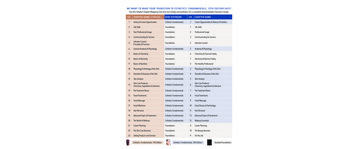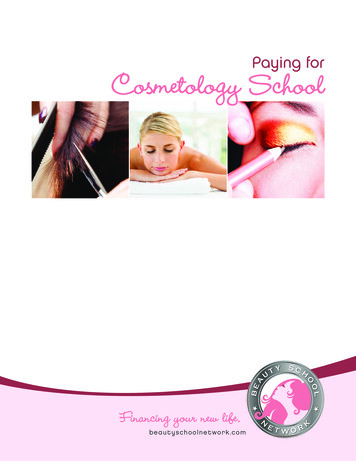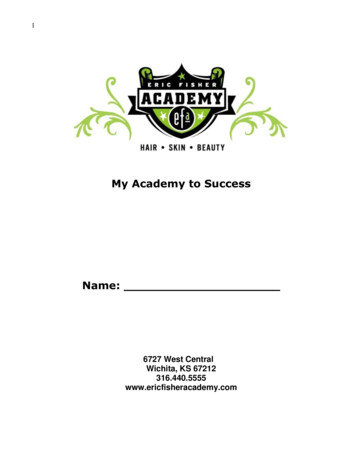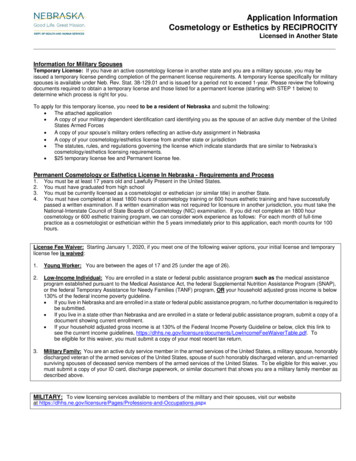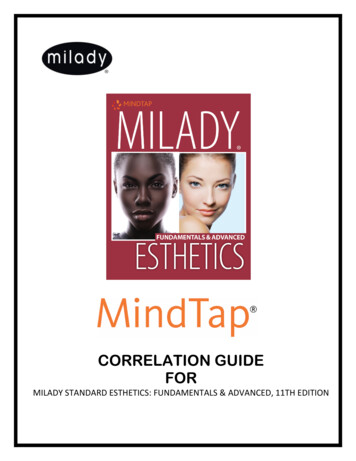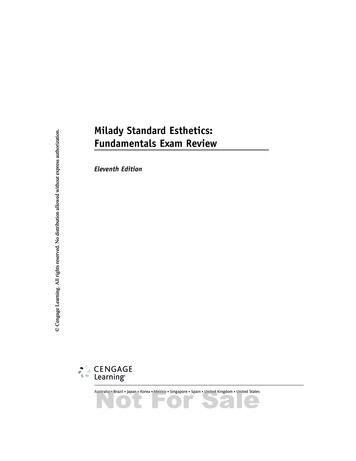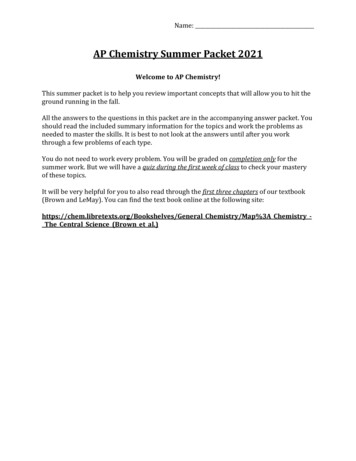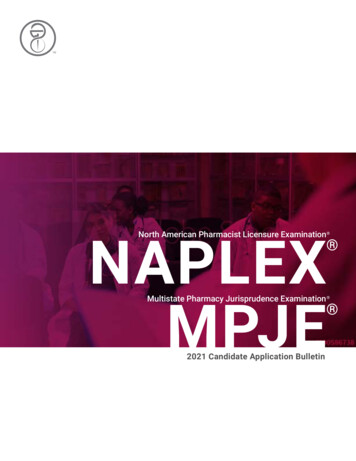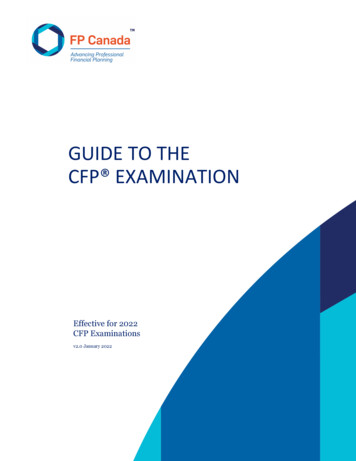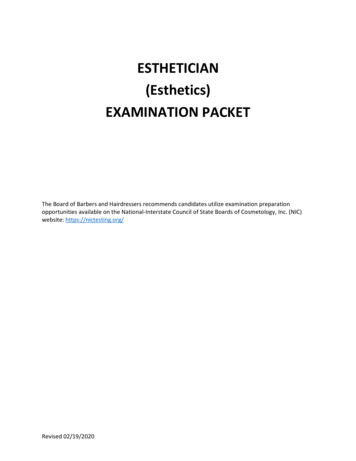
Transcription
ESTHETICIAN(Esthetics)EXAMINATION PACKETThe Board of Barbers and Hairdressers recommends candidates utilize examination preparationopportunities available on the National-Interstate Council of State Boards of Cosmetology, Inc. (NIC)website: https://nictesting.org/Revised 02/19/2020
NATIONAL ESTHETICSTHEORY EXAMINATIONCANDIDATE INFORMATION BULLETIN (CIB)Please visit your examination provider’s website for the most current bulletin prior to testing.The National Esthetics Theory Examination is the licensure examination for Estheticians, which is developed bythe National-Interstate Council of State Boards of Cosmetology (NIC). This bulletin contains IMPORTANTINFORMATION regarding the examination, including content outline covered by the theory examination, samplequestions and answers, and references. The time allowed for the Esthetics Theory Examination is 90 minutes.PLEASE REVIEW ALL INFORMATION CAREFULLYFor each NIC National Theory Examination, there are TWO (2) parts to every Candidate Information Bulletin (CIB) stored asseparate documents: Examination Content and Important Instructions – This provides information about the scope of content covered in theTheory examination and information and guidelines related to administration of the Theory examination.References – This provides a list of references used to develop and support the content covered in the examination. Thereferences are always the same for the Theory and Practical examinations.BE CERTAIN TO DOWNLOAD AND/OR PRINT AND REVIEW BOTH DOCUMENTS THATMAKE UP THE NIC EXAMINATION CIB.PLEASE REVIEW ALL INFORMATION CAREFULLY!IMPORTANT INSTRUCTIONS Do not leave the examination area without permission. Permission must be obtained to leave the examination areafor any reason, including restroom usage or at the completion of the examination. Picture ID is required for reentry into examination.With the exception of verbal instructions, the proctors and examination administration personnel are not allowedto communicate with candidates.If you have an emergency situation please notify the proctor.The following provides examples of materials and actions that are prohibited during the examinationadministration:o Possession of cellular phones, watches (of any kind), pagers, tablets, computers, projectors, cameras, any otherelectronic or recording devices, printed materials, or handwritten notes.o Communicating to other candidates.o Exhibiting disruptive behavior. The above referenced items or actions are not an exhaustive list. Failure to comply with any of theseconditions or exhibiting ANY behavior that suggests an effort to cheat will result in your immediatedismissal from the examination and your actions reported to the proper authorities.National-Interstate Council of State Boards of Cosmetology, Inc. – Esthetics Theory Examination CIB Copyright 2020 NIC All Rights Reserved1(Eff. 1/1/2020)(Rev. 2.26.2020)
NIC ESTHETICS THEORY EXAMINATION – CANDIDATE INFORMATION BULLETINESTHETICS THEORY EXAMINATION CONTENT OUTLINEThe following outlines the scope of content covered by the NIC National Esthetics Theory Examination. Thepercentages represent the percentage of items from each domain. The examination is comprised of 110 items,of which 100 items are weighted and contribute to the candidate’s final score.Domain I: SCIENTIFIC CONCEPTS (55%)A. Basic knowledge of microbiology (i.e., bacteria, viruses, parasites, fungi)B. Apply knowledge of infection control procedures related to:1. Levels of infection control (i.e., sanitation, disinfection, sterilization)2. Methods of infection control (i.e., heat, chemical agents)C. Apply knowledge of safety procedures and guidelines related to:1. Standard (Universal) Precautions2. Blood exposure procedures3. Safety Data Sheets (SDS) (e.g., manufacturer's labeling)4. Handling of chemicalsD. Demonstrate a basic understanding of human physiology and anatomy related to:1. Cells and their functions2. Tissues (i.e., epithelial, connective, nerve, muscular)3. Organs and their function (e.g., skin, lungs, heart)4. Systems and their functions (e.g., muscular, integumentary, nervous, endocrine, skeletal)E. Demonstrate an understanding of histology and physiology of the skin related to:1. Structure and function of the layers of the skin2. Structure and function of the glands3. Functions of the skin (e.g., protection, temperature regulation, absorption)F. Recognize and understand skin disorders and diseases related to:1. Disorders of the sebaceous gland (e.g., acne, milia, seborrhea)2. Disorders of the sudoriferous gland (e.g., hyperhidrosis, bromhydrosis, anhidrosis)3. Contagious diseases (e.g., bacterial conjunctivitis, herpes simplex, tinea)4. Skin inflammations (e.g., dermatitis, eczema, rosacea)5. Skin pigmentation (i.e., hyperpigmentation, hypopigmentation)6. Skin growths (e.g., skin tags, moles, keratoma)7. Skin cancers (i.e., basal cell carcinoma, squamous cell carcinoma, melanoma)8. Primary and secondary skin lesionsG. Understanding function and composition of the hair related to:1. Structure of the hair and its follicle2. Growth cycles3. Abnormal hair growth (e.g., hirsutism, hypertrichosis)H. Understanding basic chemistry as related to:1. Ingredients2. Labeling3. Function (e.g., hydration, protection, cleanse)4. Acidity/Alkalinity (i.e., pH)National-Interstate Council of State Boards of Cosmetology, Inc. – Esthetics Theory Examination CIB Copyright 2020 NIC All Rights Reserved2(Eff. 1/1/2020)(Rev. 2.26.2020)
NIC ESTHETICS THEORY EXAMINATION – CANDIDATE INFORMATION BULLETINDomain II: SKIN CARE AND SERVICES (45%)A. Demonstrate an understanding of performing a client consultation and documentation (e.g., health history,intake form,consultation chart, physician release)B. Apply knowledge of client protection (i.e., draping of head and body)C. Skin analysis (e.g., Fitzpatrick skin types/conditions/characteristics)D. Contraindications for skin servicesE. Treatment protocolF. Demonstrate an understanding of cleansing proceduresG. Demonstrate an understanding of steaming proceduresH. Demonstrate an understanding of exfoliation procedures (i.e., chemical, mechanical/manual)I. Demonstrate a basic understanding of massage movementsJ. Demonstrate an understanding of methods of extractionK. Demonstrate an understanding of the functions and applications of masks related to:1. Clay/Mud2. Gel3. Rubberized4. Cream5. Sheet mask (e.g., collagen, gauze, pre-cut)6. Thermal (e.g., paraffin, mineral)L. Demonstrate an understanding of the conclusion of facial services:1. Moisturize2. Sun protection3. Home care (i.e., after care)M. Demonstrate a basic knowledge of the use of electrical equipment used in skin servicesN. Demonstrate an understanding of makeup as related to:1. Principles (e.g., color theory)2. Product selection (e.g., lipstick, foundation)3. Application (e.g., contouring, highlighting, blending)4. Safety (e.g., bracing)5. Infection control (e.g., disposables, disinfection of tools)O. Demonstrate a basic knowledge of other services related to:1. Facial services (e.g., aromatherapy, pre- and post-surgical/medical treatments, ultrasonic)2. Body treatments (body wraps, body scrubs, sunless tanning)3. Eyelash and eyebrow services (e.g., lash and brow tinting, artificial lashes, lashlifting/perming)4. Demonstrate an understanding of hair removal methods and procedures (i.e., waxing,tweezing)5. Wellness programsNational-Interstate Council of State Boards of Cosmetology, Inc. – Esthetics Theory Examination CIB Copyright 2020 NIC All Rights Reserved3(Eff. 1/1/2020)(Rev. 2.26.2020)
NIC ESTHETICS THEORY EXAMINATION – CANDIDATE INFORMATION BULLETINESTHETICS SAMPLE QUESTIONSThe following sample questions are similar to those on the NIC Esthetics Theory Examination. Each question is followedby four answer options. Only one option is correct. Correct answers (keys) are listed following the sample questions.1.What is the term for the scientific study of the skin?a. Myologyb. Angiologyc. Physiologyd. Dermatology2.A product containing antiseptic reaches what level of decontamination?a. Disinfectionb. Sterilizationc. Ionizationd. Sanitation3.Which of the following is also referred to as the basal layer?a. Stratum granulosumb. Stratum lucidumc. Stratum germinativumd. Stratum corneum4.During the anagen phase of hair growth, the hair isa. beginning to destroy itself.b. actively growing.c. shedding.d. disconnecting from the papilla.5.A new client schedules a series of chemical exfoliation treatments. When should the consultation form bereviewed and signed?a. Monthlyb. Annuallyc. At the first treatmentd. At each treatment6.Dilated capillaries that can be seen beneath the surface of the skin are known asa. seborrhea.b. keratoma.c. telangectasia.d. dehydrated.7.Melanocytes that are more active will producea. lighter skin.b. darker skin.c. sebaceous skin.d. dry skin.National-Interstate Council of State Boards of Cosmetology, Inc. – Esthetics Theory Examination CIB Copyright 2020 NIC All Rights Reserved4(Eff. 1/1/2020)(Rev. 2.26.2020)
NATIONAL ESTHETICS이론 시험응시자 정보 요강(CIB)시험을 보기 전에 시험 제공업체의 웹사이트를 방문해서 최신 요강을 확인하십시오.National Esthetics 이론 시험은 Estheticians에 대한 면허 교부 시험으로서 National-Interstate Council of StateBoards of Cosmetology (NIC)가 개발한 것입니다. 본 요강에는 이론 시험에서 다루는 내용의개요, 질문 및 응답의 사례, 그리고 참조 문헌 등을 비롯하여 시험과 관련된 중요정보가 포함되어 있습니다. Esthetics 이론 시험에 허용되는 시간은 90분입니다.모든 정보를 주의 깊게 검토하십시오.각 NIC National 이론 시험에 있어서, 모든 응시자 정보 요강(CIB)은 별도의 문서로 저장된 2개의 파트로 구성됩니다. 시험 요강 및 중요 지침 – 이 문서는 이론 시험에서 다루는 내용의 범위에 대한 정보와 이론 시험의 관리와 관련된 정보 및 지침을 제공합니다.참조 문헌 – 이 문서는 시험에서 다루는 내용을 개발하고 지원하기 위해 사용되는 참조 문헌의 목록입니다. 참조문헌은 이론 시험과 실기 시험에 대해 동일합니다.반드시 NIC 시험 CIB를 구성하는 두 가지 문서 모두를 다운로드 및/또는 인쇄하고 검토하십시오.모든 정보를 주의 깊게 검토하십시오!중요 지침 허락 없이 시험장을 떠나지 마십시오. 화장실을 가거나 시험을 완료한 경우를 비롯하여 어떠한 이유에서든시험장을 떠나려면 허락을 받아야 합니다. 시험장에 재입장하려면 사진 ID가 필요합니다.구두 지시문을 제외하면 시험 감독관과 시험 관리 직원은 응시자와 대화를 할 수 없습니다.응급 상황이 발생하는 경우 시험 감독관에게 알려주십시오.다음은 시험이 시행되는 동안 금지되는 재료 및 행동의 예를 요약한 것입니다.ooo휴대폰, 손목시계(모든 종류), 호출기, 태블릿, 컴퓨터, 프로젝터, 카메라, 또는 기타 전자 또는 녹화장치, 인쇄물 또는 수기 노트의 지참.다른 응시자와의 대화.방해하는 행동 표출. 상기의 참조 항목이나 행동은 포괄적인 목록이 아닙니다. 이러한 조건을 준수하지 않거나부정행위를 하려는 의도로 의심되는 행동을 보여주는 경우 즉각적으로 시험에서 퇴실 조치를당하고 그 행동을 해당 기관에 통보할 것입니다.National-Interstate Council of State Boards of Cosmetology, Inc. – Esthetics 이론 시험 CIB (KOR) Copyright 2020 NIC All Rights Reserved1(발효일 2020년 1월 1일) (Eff. 1/1/2020)(개정일 2020년 2월 26일) (Rev. 2.26.2020)
NIC ESTHETICS 이론 시험 – 응시자 정보 요강ESTHETICS 이론 시험 내용 개요다음은 NIC National Esthetics 이론 시험에서 다루는 응시 범위에 대한 개요를 제공합니다. 퍼센트는 각부문의 문항 퍼센트를 나타냅니다. 시험은 110개 문항으로 구성되며, 이 중 100개 문항에 가중치가적용되어 응시자의 최종 점수에 반영됩니다.영역 I: 과학적 개념(55%)A. 미생물에 대한 기본 지식(예를 들어, 박테리아, 바이러스, 기생충, 진균)B. 다음과 관련된 감염 관리 절차에 대한 지식을 적용합니다.1. 감염 관리 수준(예를 들어, 위생, 소독, 살균)2. 감염 관리 방법(예를 들어, 열, 화학 제제)C. 다음과 관련된 안전 절차 및 지침에 대한 지식을 적용합니다.1. 표준(범용) 예방 조치2. 혈액 노출 절차3. 안전보건자료(SDS)(예를 들어, 제조업체의 라벨링)4. 화학물 취급D. 다음과 관련된 인간 생리학 및 해부학에 대한 기본적인 이해를 보여줍니다.1. 세포 및 그 기능2. 조직(예를 들어, 상피, 결합, 신경, 근육)3. 장기 및 기타 기능(예를 들어, 피부, 폐, 심장)4. 계통 및 기능(예를 들어, 근육계, 외피계, 신경계, 내분비계, 골격계)E. 다음과 관련된 피부 조직학 및 생리학에 대해 이해하고 있음을 보여줍니다.1. 피부 층의 구조 및 기능2. 분비선의 구조 및 기능3. 피부 기능(예를 들어, 보호, 체온 조절, 흡수)F. 다음과 관련된 피부 질환 및 질병을 인식하고 이해합니다.1. 피지선 이상(예를 들어, 여드름, 한진, 지루증)2. 땀샘 이상(예를 들어, 다한증, 취한증, 무한증)3. 전염성 질환(예를 들어, 세균성 결막염, 단순포진, 백선)4. 피부 염증(예를 들어, 피부염, 습진, 주사비)5. 피부 색소(예를 들어, 과다색소침착, 색소침착저하증)6. 피부 성장(예를 들어, 사마귀, 혹, 각병종)7. 피부암(예를 들어, 기저세포암, 편평상피세포암, 악성 흑색종)8. 1차 및 2차 피부 병변G. 다음과 관련된 모발의 기능 및 구성에 대해 이해합니다.1. 모발 및 모낭의 구조2. 성장 주기3. 비정상적 모발 성장(예를 들어, 다모증)H. 다음과 관련된 기본 화학 성분에 대해 이해합니다.1. 성분2. 라벨3. 기능(예를 들어, 수분 공급, 보호, 세정)4. 산성/염기성(pH)National-Interstate Council of State Boards of Cosmetology, Inc. – Esthetics 이론 시험 CIB (KOR) Copyright 2020 NIC All Rights Reserved2(발효일 2020년 1월 1일) (Eff. 1/1/2020)(개정일 2020년 2월 26일) (Rev. 2.26.2020)
NIC ESTHETICS 이론 시험 – 응시자 정보 요강영역 II: 피부 관리 및 서비스(45%)A. 고객 상담 및 문서화(예를 들어, 병력, 흡입 형태, 상담 차트, 의사 발표)의 수행에 대한 이해를보여줍니다.B. 고객 보호(예를 들어, 머리 및 몸에 드레이핑)에 대한 지식을 적용합니다.C. 피부 분석(예를 들어, 피츠패트릭(Fitzpatrick) 피부 타입/상태/특성)D. 피부 서비스에 대한 금기 사항E. 치료 방침F. 클렌징 절차에 대한 이해를 보여줍니다.G. 스티밍 절차에 대한 이해를 보여줍니다.H. 각질 제거 절차(예를 들어, 화학적, 기계적/수동)에 대한 이해를 보여줍니다.I. 마사지 운동에 대한 기본적인 이해를 보여줍니다.J. 추출 방법에 대한 이해를 보여줍니다.K. 다음과 관련하여 마스크의 기능 및 어플리케이션에 대한 이해를 보여줍니다.1. 진흙/머드2. 젤3. 고무 도포4. 크림5. 시트 마스크(예를 들어, 콜라겐, 거즈, 프리컷)6. 열(예를 들어, 파라핀, 미네랄)L. 페이셜 서비스의 결론에 대한 이해를 보여줍니다.1. 보습2. 자외선 보호3. 홈 케어(예를 들어, 사후 치료)M. 피부 서비스에 사용되는 전기 장비의 사용법에 관한 기본 지식을 보여줍니다.N. 다음과 관련하여 메이크업에 대한 이해를 보여줍니다.1. 원칙(예를 들어, 색상 이론)2. 제품 선택(예를 들어, 립스틱, 파운데이션)3. 어플리케이션(예를 들어, 윤곽, 하이라이팅, 블렌딩)4. 안전(예를 들어, 브레이싱)5. 감염 관리(예를 들어, 일회용품, 기구 소독)O. 다음과 관련된 기타 서비스에 대한 기본적인 지식을 보여줍니다.1. 페이셜 서비스(예를 들어, 아로마테라피, 수술 전후/의료 치료, 초음파)2. 바디 트리트먼트(바디 랩, 바디 스크럽, 실내 선탠)3. 속눈썹 및 눈썹 서비스(예를 들어, 속눈썹 및 눈썹 착색, 인공 속눈썹, 속눈썹리프팅/퍼밍)4. 제모 방법 및 절차에 대한 이해를 보여줍니다(예를 들어, 왁싱, 족집게 절차)5. 웰빙 프로그램National-Interstate Council of State Boards of Cosmetology, Inc. – Esthetics 이론 시험 CIB (KOR) Copyright 2020 NIC All Rights Reserved3(발효일 2020년 1월 1일) (Eff. 1/1/2020)(개정일 2020년 2월 26일) (Rev. 2.26.2020)
NIC ESTHETICS 이론 시험 – 응시자 정보 요강ESTHETICS 질문 예제다음의 질문은 NIC Esthetics 이론 시험에 나오는 것과 유사한 질문의 예입니다. 각 질문 다음에는 4개의 선택답안이 있습니다. 단 하나의 항목만이 정답입니다. 정답(키)은 예제 질문 다음에 명시되어 있습니다.1.피부의 과학적인 연구를 지칭하는 용어는?a. 근육학b. 맥관학c. 생리학d. 피부과학2.소독제를 함유하고 있는 제품은 어느 단계까지의 정화를 해야 하는가?a. 소독(Disinfection)b. 살균(Sterilization)c. 이온화(Ionization)d. 위생(Sanitation)3.다음 중 기저층이라고도 하는 것은?a. 과립층(Stratum granulosum)b. 투명층(Stratum lucidum)c. 기저층(Stratum germinativum)d. 각질층(Stratum corneum)4.모발 성장의 생장기가 진행되는 동안 모발은 어떻게 되는가?a. 자신을 파괴하기 시작한다.b. 활발하게 성장한다.c. 벗겨진다.d. 돌기로부터 분리된다.5.신규 고객이 일련의 화학적 박리법 치료를 예약하고 있다. 상담 양식을 검토하고 서명해야 하는 시기는?a. 매월b. 매년c. 치료 시작시d. 매 치료시6.피부 아래로 확장된 모세혈관이 보이는 것을 무엇이라고 하는가?a. 지루증(Seborrhea)b. 각병종(Keratoma)c. 모세혈관 확장증(Telangectasia)d. 탈수증(Dehydrated)7.활동성이 좋은 멜라닌 세포로 인한 결과는?a. 밝은 피부b. 어두운 피부c. 피지가 많은 피부d. 건조한 피부National-Interstate Council of State Boards of Cosmetology, Inc. – Esthetics 이론 시험 CIB (KOR) Copyright 2020 NIC All Rights Reserved4(발효일 2020년 1월 1일) (Eff. 1/1/2020)(개정일 2020년 2월 26일) (Rev. 2.26.2020)
NIC ESTHETICS 이론 시험 – 응시자 정보 요강8.페이셜 스팀기의 기능은 모공을 부드럽게 하는 것 이외에도 무엇이 있는가?a. 피부에 산소를 공급한다.b. 피부에 수분을 공급한다.c. 혈액 순환을 저하시킨다.d. 피부의 독소를 제거한다.정답1. d2. d3. c4. b5. d6. c7. b8. aNational-Interstate Council of State Boards of Cosmetology, Inc. – Esthetics 이론 시험 CIB (KOR) Copyright 2020 NIC All Rights Reserved5(발효일 2020년 1월 1일) (Eff. 1/1/2020)(개정일 2020년 2월 26일) (Rev. 2.26.2020)
EXAMEN TEÓRICONACIONAL DE ESTÉTICABOLETÍN DE INFORMACIÓN PARA CANDIDATOSVisite el sitio web de su proveedor de exámenes para ver el boletín más actualizado antes del examen.El Examen Teórico Nacional de Estética es el examen para obtener la licencia de Esteticista, desarrollado por elNational-Interstate Council of State Boards of Cosmetology (Consejo Nacional Interestatal de Juntas Estatales deCosmetología, NIC). Este boletín contiene INFORMACIÓN IMPORTANTE en relación con el examen,incluyendo una descripción del contenido cubierto por el examen de teoría, muestras de preguntas y respuestas, yreferencias. El tiempo asignado para el Examen Teórico de Estética es de 90 minutos.REVISE CUIDADOSAMENTE TODA LA INFORMACIÓN.INSTRUCCIONES IMPORTANTES No abandone el área de examen sin permiso. Debe obtenerse permiso para abandonar el área de examen porcualquier razón, incluido el uso del baño, o al final del examen. Se requiere una identificación con fotografía paravolver a ingresar al examen.Con excepción de las instrucciones verbales, los supervisores y el personal de administración del examen notienen permitido comunicarse con los candidatos.Si tiene alguna situación de emergencia, notifíquela al supervisor del examen.A continuación se presentan ejemplos de materiales y acciones que están prohibidos durante la administracióndel examen:o Posesión de teléfonos celulares, buscapersonas, tabletas, computadoras, proyectores, cámaras, o cualquierotro dispositivo electrónico o de grabación, materiales impresos, o notas escritas a mano.o Comunicarse con otros candidatos.o Exhibir falta de disciplina. Los elementos o acciones anteriormente mencionados no son una lista exhaustiva. Dejar de cumplircon cualquiera de estas condiciones, o exhibir CUALQUIER comportamiento que sugiera un intentode hacer trampa dará como resultado su destitución inmediata del examen y se informarán susacciones a las autoridades apropiadas.DESCRIPCIÓN DEL CONTENIDO DEL EXAMEN TEÓRICO DE ESTÉTICA1.CONCEPTOS CIENTÍFICOS (55 %)A.Aplicar el conocimiento de los procedimientos de control de infecciones en relación .Hongos2.Control de la infeccióna.Niveles para el control de la infeccióni.Limpieza e .Métodos para el control de la infeccióni.Calorii.Agentes químicos3.Procedimientos y lineamientos de seguridadb.Exposición/contacto con sangreCopyright, National-Interstate Council of State Boards of Cosmetology, Inc. – Examen Teórico de Estética CIB1Rev. 9/2014Efec. 2/2015
EXAMEN DE TEORÍA PARA ESTÉTICA NIC – BOLETÍN DE INFORMACIÓN PARA CANDIDATOS2.B.Demostrar entendimiento de la fisiología y anatomía humana básica en lo relacionado con:1.Célulasa.Estructurab.Crecimiento y iosod.Muscular3.Órganos y sus funciones (por ejemplo, piel, pulmones, corazón)4.Sistemas y sus funciones (por ejemplo, muscular, tegumentario, nervioso)C.Demostrar entendimiento de la histología y fisiología de la piel en relación con:1.Estructura y función de las capas de la piel2.Estructura y función de las glándulas3.Estructura del folículo piloso4.Funciones de la piel (por ejemplo, protección, regulación de la temperatura, absorción)D.Demostrar entendimiento de los trastornos y enfermedades de la piel en lo relacionado con:1.Trastornos de las glándulas sebáceas (por ejemplo, acné, acné miliar, seborrea)2.Trastornos de las glándulas sudoríparas (por ejemplo, hiperhidrosis, bromhidrosis, anhidrosis)3.Enfermedades contagiosas (por ejemplo, conjuntivitis bacteriana, herpes simple, tiña)4.Inflamaciones de la piel (por ejemplo, dermatitis, eccema, rosácea)5.Pigmentación de la piel (por ejemplo, hiperpigmentación, hipopigmentación)6.Crecimientos de la piel (por ejemplo, verrugas, lunares, queratomas)7.Cánceres de la piel (por ejemplo, carcinoma de célula basal, carcinoma de células escamosas, melanoma maligno)8.Lesiones cutáneas (por ejemplo, queloide, cicatrices, úlceras)E.Entender la composición del vello corporal en relación con:1.Estructura y crecimiento del pelo2.Crecimiento anormal del pelo (por ejemplo, hirsutismo, hipertricosis)F.Demostrar entendimiento de la química básica, incluida la composición y propósito de los productos cosméticos enrelación con:1.Ingredientes (por ejemplo, péptidos, humectantes)2.Etiquetado3.Función (por ejemplo, hidratación, protección, limpieza)4.Acidez/alcalinidad (es decir, pH)CUIDADO Y SERVICIOS DE LA PIEL (45 %)A.Demostrar entendimiento de cómo llevar a cabo la consulta y documentación con un cliente en lo relacionado con:1.Análisis de la piela.Escala de Fitzpatrickb.Tipo de pielc.Condición de la piel2.Registro del cliente (por ejemplo, historial de salud, forma de ingreso, tabla de consultas)3.Protocolo de tratamiento4.Contraindicaciones para servicios dermatológicosB.Demostrar entendimiento de los procedimientos de limpiezaC.Demostrar entendimiento de los procedimientos de vaporización (por ejemplo, toalla y vaporizador)D.Demostrar entendimiento de los procedimientos de exfoliación en lo relacionado con:1.Químicos (por ejemplo, AHA, BHA, enzimas)2.Físicos (por ejemplo, frotado, cepillado, microdermoabrasión)3.GommageCopyright, National-Interstate Council of State Boards of Cosmetology, Inc. – Examen Teórico de Estética CIB2Rev. 9/2014Efec. 2/2015
EXAMEN DE TEORÍA PARA ESTÉTICA NIC – BOLETÍN DE INFORMACIÓN PARA CANDIDATOSE.Demostrar entendimiento de los procedimientos de extracciónF.Demostrar entendimiento de los movimientos y efectos del masajeG.Demostrar entendimiento del uso de mascarillas en relación con:1.Arcilla/Lodo2.Gel3.Con cobertura de caucho4.CremaH.Demostrar entendimiento de los métodos y procedimientos de depilación en lo relacionado con:1.Depilación con cera (es decir, dura y blanda)2.Depilado con pinzasI.Demostrar entendimiento de los principios y procedimientos para la aplicación del maquillaje en relación con:1.Análisis de las formas y características de la cara2.Teoría del color3.AplicacionesJ.Demostrar conocimiento del uso del equipo eléctrico durante los servicios dermatológicos en relación con:1.Lámpara de magnificación2.Lámpara de Wood3.Vaporizador facial4.Máquina de alta frecuencia5.Terapia r conocimiento básico de otros servicios en relación con:1.Tratamientos corporales2.Extensiones de pestañasPREGUNTAS DE EJEMPLO PARA ESTÉTICALos siguientes ejemplos de preguntas son similares a las del Examen Teórico de Estética NIC. Cada pregunta está seguida por cuatroopciones de respuesta. Solo una opción es correcta. Las respuestas correctas (claves) se enlistan a continuación de los ejemplos depreguntas.1.¿Cuál es el término para el estudio científico de la piel?a. Miología.b. Angiología.c. Fisiología.d. Dermatología.2.¿Qué nivel de descontaminación alcanza un producto que contiene antiséptico?a. Desinfección.b. Esterilización.c. Ionización.d. Saneamiento.3.¿Cuál de las siguientes se denomina también capa basal?a. Estrato granuloso.b. Estrato lúcido.c. Estrato germinativo.d. Estrato córneo.Copyright, National-Interstate Council of State Boards of Cosmetology, Inc. – Examen Teórico de Estética CIB3Rev. 9/2014Efec. 2/2015
EXAMEN DE TEORÍA PARA ESTÉTICA NIC – BOLETÍN DE INFORMACIÓN PARA CANDIDATOS4.Durante la fase de anagénesis el crecimiento capilar, el peloa. comienza destruirse a sí mismo.b. crece activamente.c. se cae.d. se desconecta de la papila.5.Un cliente nuevo programa una serie de tratamientos de exfoliación con productos químicos. ¿Cuándo debe revisarse y firmarseel formulario de la consulta?a. Mensualmente.b. Anualmente.c. En el primer tratamiento.d. En cada tratamiento.6.Los capilares dilatados que pueden verse por debajo de la superficie de la piel se conocen comoa. seborrea.b. queratoma.c. telangectasia.d. deshidratación.7.Los melanocitos que son más activos producirána. piel más clara.b. piel más oscura.c. piel sebácea.d. piel seca.8.Además de suavizar el sebo, otra función de un vaporizador facial esa. oxigenar la piel.b. humectar la piel.c. disminuir la circulación.d. desintoxicar la piel.Respuestas1. d2. d3. C4. B5. D 7. b6. C 8. aREFERENCIAS ESTÉTICASREFERENCIAS PRIMARIASMilady’s Standard Esthetics: Fundamentals2013, 11.va EdiciónJoel Gerson, Janet D’Angelo, Sallie Deitz et alMilady5 Maxwell DriveClifton Park NY 12065-2919www.milady.cengage.comCopyright, National-Interstate Council of State Boards of Cosmetology, Inc. – Examen Teórico de Estética CIB4Rev. 9/2014Efec. 2/2015
EXAMEN DE TEORÍA PARA ESTÉTICA NIC – BOLETÍN DE INFORMACIÓN PARA CANDIDATOSSalon Fundamentals Esthetics – A Resource for Your Skin Care Career2007, 11.va impresión, 2.da Edición, agosto de 2013Pivot Point International, Inc.World Headquarters1560 Sherman Avenue, Suite 700Evanston, IL 60201800-886-4247www.pivot-point.comNIC Infection Control and Safety StandardsAdoptado en 1998: Revisado en octubre de 2002, Revisado en agosto de 2014National-Interstate Council of State Boards of Cosmetologyhttp://nictesting.org/memberinfo/NIC Health & Safety Standards- Aug 2014.pdfREFERENCIAS DE APOYOSalon Fundamentals Esthetics – A Resource for Your Skin Care Career2007, 10.a impresión, 2.a Edición, septiembre de 2012Pivot Point International, Inc.World Headquarters1560 Sherman Avenue, Suite 700Evanston, IL 60201800-886-4247www.pivot-point.comSalon Fundamentals Esthetics – A Resource for Your Skin Care Career2007, 7.a impresión, 2.a Edición, febrero de 2011Pivot Point International, Inc.World Headquarters1560 Sherman Avenue, Suite 700Evanston, IL 60201800-886-4247www.pivot-point.comMilady’s Standard Esthetics: Fundamentals2009, 10.a EdiciónJoel Gerson, Janet D’Angelo, Sallie Deitz et alDelmar5 Maxwell DriveClifton Park NY 12065-2919www.delmar.cengage.comCopyright, National-Interstate Council of State Boards of Cosmetology, Inc. – Examen Teórico de Estética CIB5Rev. 9/2014Efec. 2/2015
KỲ THI LÝ THUYẾTTHẨM MỸ QUỐC GIABẢN TIN DÀNH CHO THÍ SINH (CIB)Vui lòng truy cập trang web của đơn vị tổ chức kỳ thi dànhcho bạn để xem bản tin mới nhất trước khi dự thi.Kỳ Thi Lý Thuyết Thẩm Mỹ Quốc Gia là kỳ thi cấp giấy phép hành nghề Thẩm Mỹ doHội Đồng Thẩm Mỹ Liên Tiểu Bang (NIC) tổ chức. Bản tin này chứa THÔNG TIN QUAN TRỌNGvề kỳ thi, bao gồm phạm vi nội dung của bài thi lý thuyết, câu hỏi mẫu và câu trả lời, tài liệu tham khảo.Thời gian cho phép của Bài Thi Lý Thuyết Thẩm Mỹ là 90 phút.VUI LÒNG XEM KỸ LẠI TẤT CẢ THÔNG TINĐối với mỗi Kỳ Thi Lý Thuyết Quốc Gia của NIC, tất cả Bản Tin Dành Cho Thí Sinh (CIB) đều có HAI (2) phần được lưu thành cáctài liệu riêng: Nội Dung Bài Thi và Hướng Dẫn Quan Trọng – Phần này cung cấp thông tin về phạm vi nội dung của bài thi Lý Thuyết,thông tin và hướng dẫn liên quan đến việc quản lý bài thi Lý Thuyết.Tài Liệu Tham Khảo – Phần này cung cấp danh sách tài liệu tham khảo dùng để phát triển và hỗ trợ nội dung trong bàithi. Các tài liệu tham khảo dành cho bài thi Lý Thuyết và Thực Hành là giống nhau.HÃY ĐẢM BẢO TẢI XUỐNG VÀ/HOẶC IN ĐỒNG THỜI XEM LẠI CẢ HAI TÀI LIỆU HÌNHTHÀNH NÊN CIB CHO KỲ THI CỦA NIC.VUI LÒNG XEM KỸ LẠI TẤT CẢ THÔNG TIN!HƯỚNG DẪN QUAN TRỌNG Thí sinh không được ra khỏi khu vực thi nếu không được cho phép. Để ra khỏi khu vực thi vì bất kỳ lý do gì, kể cảđi vệ sinh hay khi hoàn thành xong bài thi, thí sinh đều phải xin phép. Thí sinh phải có ID dán ảnh mới được vàolại phòng thi.Trừ các hướng dẫn bằng lời nói, giám thị và nhân viên quản lý kỳ thi không được phép giao tiếp với thí sinh.Vui lòng thông báo cho giám thị nếu bạn gặp phải tình huống khẩn cấp.Sau đây là ví dụ về các vật dụng và hành động bị cấm trong quá trình quản lý thi:o Mang theo điện thoại di động, đồng hồ (bất kỳ loại nào), máy nhắn tin, máy tính bảng, máy tính, máy chiếu,máy ảnh hoặc bất kỳ thiết bị điện tử hay ghi âm nào khác, các tài liệu in ấn hoặc ghi chú viết tay.o Trao đổi với thí sinh khác.o Có hành vi gây rối. Những vật dụng hoặc hành động nói trên không phải là danh sách đầy đủ. Việc không tuân thủ bất kỳđiều kiện nào trong số này hoặc có BẤT KỲ hành vi nào cho thấy bạn tìm cách gian lận sẽ dẫn đếnviệc bị đình chỉ thi ngay lập tức và hành động của bạn sẽ được báo cáo cho các cơ quan chức năngthích hợp.National-Interstate Council of State Boards of Cosmetology, Inc. – Esthetics Theory CIB (VIET) Kỳ Thi Lý Thuyết Thẩm Mỹ1(Có hiệu lực từ ngày 1 tháng 1 năm 2020 (Eff. 1/1/2020) ) Bản quyền 2020 NIC Mọi Quyền Được Bảo Lưu(Bản sửa đổi ngày 26 tháng 2 năm 2020) (Rev. 2.26.2020)
KỲ THI LÝ THUYẾT THẨM MỸ CỦA NIC - BẢN TIN DÀNH CHO THÍ SINHPHẠM VI NỘI DUNG BÀI THI LÝ THUYẾT THẨM MỸSau đây là phác thảo phạm vi nội dung của Bài Thi Lý Thuyết Thẩm Mỹ Quốc Gia của NIC. Tỷ lệ phần trămđại diện cho tỷ lệ phần trăm của các mục có ở mỗi phần. Bài thi bao gồm 110 mục, trong đó 100 mục có trọngsố và đóng góp vào điểm số cuối cùng của thí sinh.Phần I: KHÁI NIỆM KHOA HỌC (55%)A. Kiến thức cơ bản về vi sinh vật học (tức là vi khuẩn, vi rút, ký sinh trùng, nấm)B. Áp dụng kiến thức về quy trình kiểm soát lây nhiễm liên quan đến:1. Mức độ kiểm soát lây nhiễm (tức là vệ sinh, khử trùng, tiệt khuẩn)2. Phương pháp kiểm soát lây nhiễm (tức là nhiệt, hóa chất)C. Áp dụng kiến thức về quy trình và hướng dẫn an toàn liên quan đến:1. Phòng Ngừa Tiêu Chuẩn (Chung)2. Quy trình tiếp xúc với máu3. Bảng Dữ Liệu An Toàn (SDS) (tức là nhãn của nhà sản xuất)4. Xử lý hóa chấtD. Thể hiện sự hiểu biết cơ bản về sinh lý học và giải phẫu ở người liên quan đến:1. Tế bào và chức năng của tế bào2. Các loại mô (tức là biểu mô, mô liên kết, mô thần kinh, mô cơ)3. Cơ quan và chức năng của cơ quan (ví dụ: da, phổi, tim)4. Hệ thống và chức năng của hệ thống (ví dụ: hệ cơ, hệ da, hệ thần kinh, hệ nội tiết, hệ xương)E. Thể hiện sự hiểu biết về mô học và sinh lý của da liên quan đến:1. Cấu trúc và chức năng của các lớp da2. Cấu trúc và chức năng của các tuyến3. Chức năng của da (ví dụ: bảo vệ, điều hòa thân nhiệt, hấp thụ)F. Nhận biết và hiểu các rối loạn và bệnh về da liên quan đến:1. Rối loạn tuyến bã nhờn (ví dụ: mụn trứng cá, mụn thịt, tăng tiết bã nhờn)2. Rối loạn tuyến mồ hôi (ví dụ: tăng tiết mồ hôi, chứng mồ hôi nặng mùi, giảm tiết mồ hôi)3. Các bệnh truyền nhiễm (ví dụ: viêm màng kết do vi khuẩn, mụn rộp, bệnh nấm ngoài da)4. Viêm da (ví dụ: chứng viêm da, chàm, chứng đỏ mặt)5. Sự hình thành sắc tố da (tức là tăng sắc tố da, giảm sắc tố da)6. U ở da (ví dụ: mụn thịt dư, nốt ruồi, u sừng)7. Ung thư da (tức là ung thư biểu mô tế bào đáy, ung thư biểu mô tế bào vảy, ung thư tế bàohắc tố)8. Tổn thương da nguyên phát và thứ phátG. Hiểu biết về chức năng và thành phần của tóc liên quan đến:1. Cấu trúc tóc và nang tóc2. Chu kỳ tăng trưởng3. Mọc lông bất thường (ví dụ: chứng rậm lông, bệnh người sói)H. Hiểu biết về hóa học cơ bản liên quan đến:1. Thành phần2. Dán nhãn3. Chức năng (ví dụ: dưỡng ẩm, bảo vệ, làm sạch)4. Tính axit/Tính kiềm (tức độ pH)National-Interstate Council of State Boards of Cosmetology, Inc. – Esthetics Theory CIB (VIET) Kỳ Thi Lý Thuyết Thẩm Mỹ2(Có hiệu lực từ ngày 1 tháng 1 năm 2020 (Eff. 1/1/2020) ) Bản quyền 2020 NIC Mọi Quyền Được Bảo Lưu(Bản sửa đổi ngày 26 tháng 2 năm 2020) (Rev. 2.26.2020)
KỲ THI LÝ THUYẾT THẨM MỸ CỦA NIC - BẢN TIN DÀNH CHO THÍ SINHPhần II: CHĂM SÓC DA VÀ DỊCH VỤ (45%)A. Thể hiện sự hiểu biết về việc thực hiện tư vấn và phân loại khách hàng (ví dụ: tiền sử sức khỏe, hình thứctiếp nhận, biểu đồ tư vấn, phát hành của bác sĩ)B. Áp dụng kiến thức về bảo vệ khách hàng (tức là quấn khăn lên đầu và phủ khăn lên cơ thể)C. Phân tích da (ví dụ: loại/điều kiện/đặc điểm da theo thang Fitzpatrick)D. Chống chỉ định đối với các dịch vụ daE. Phác đồ điều trịF. Thể hiện sự hiểu biết về các quy trình làm sạchG. Thể hiện sự
The National Esthetics Theory Examination is the licensure examination for Estheticians, which is developed by the National-Interstate Council of State Boards of Cosmetology (NIC). This bulletin contains IMPORTANT INFORMATION regarding the examination, including content outline c
